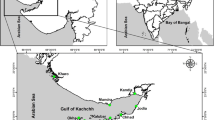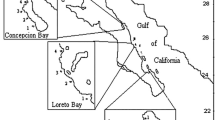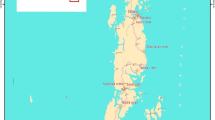Abstract
To understand natural and anthropic control of mangrove vegetation in the Gulf of Kachchh, a study was undertaken of its vegetation structure. Over 2 years (1999–2000) at three sites, mangrove vegetation was studied, including tree density, tree height, tree girth at breast height (GBH), canopy index, regeneration class and recruitment class, together with physico-chemical characteristics of water and sediment and the textural aspects of sediments. Reflecting the hot, arid hinterland of Gujarat, ambient temperatures and salinities are high in this macrotidal estuary, decreasing somewhat during the monsoon. The littoral soil supporting the mangrove is abundant in silty loam, silty clay and slity clay loam. The density of mature trees (Mangrove plants of GBH > 25 cm) ranged from 2088/ha to 3011/ha, the height of the trees ranged from 1.42 m to 9 m and the maximum mean GBH at all three sites was 33 cm, and the mean canopy indices ranged between 4.77 m2 and 10.45 m2. The maximum density of regeneration stages was 100,800/ha while that of recruitment stages was only 3,040/ha. While quite severely impacted by anthropic exploitation at one site, the mangrove ecosystem of Gulf of Kachchh was found to be mainly healthy and supporting associated organisms. The ecological and social role of the mangrove, and the potential for its future conservation are briefly discussed in the light of current legislation.



























Similar content being viewed by others
References
Anjali P, Nayak S, Trivedi CR, Kadri SA, Prasad KN (1987) Wetland mapping of a part of the Gulf of Kachchh using land sat data. In: Remote Sensing Application in Coastal Studies. Scientific Report. Space Application Center, Ahmedabad. IRS-VP/SAC/MCE/SN/08/87, pp 1–12
Arthur R (2000) Coral bleaching and mortality in three Indian reef regions during an ElNino southern oscillation event. Curr Sci 79:12
Asha PS, Diwakar R (2007) Hydrobiology of the inshore waters off Tuticorin in the Gulf. J Mar Biol Ass India 49:7–11
Ashok Prabu V, Rajkumar M, Perumal P (2008) Seasonal variations in physico-chemical characteristics of Pichavaram mangroves, southeast coast of India. J Environ Biol 29:945–950
Azariah J, Banth P, Azariah H, Selvam V (1986) Impact of urbanization on the status of mangroves of Madras In: Hook DD, Mckee WH, Smith HK, Gregory J, Matthews TD, Shear TH (eds) The Ecology and Management of Wetlands. Management, use and value of wetlands, Croom Helm, London, 2:225–233
Azariah J, Azariah H, Gunasekaran S, Selvam V (1992) Structure and species distribution in Coringa mangrove forest, Godavari delta, Andrapradesh, India. Hydrobiologia 247:11–16
Bahuguna A (1997) Coral reefs and mangrove ecosystems of marine national park, Gulf of Kachchh: A review of ecological study using satellite data. In: Sinha MP (ed) Recent advances in ecobiological research, vol 1. APH, New Delhi, pp 197–207
Banerjee LK, Sastry ARK, Nayar MP (1989) Mangroves in India. Identification manual. Botanical survey of India, Calcutta, p 113
Blasco F (1977) Outlines of ecology, botany and forestry of the mangals of Indian sub-continent. In: Chapman VJ (ed) Ecosystems of the world 1: Wet coastal ecosystems. Elsevier Scientific, New York, pp 241–258
Bosire JO, Dahdouh-Guebas F, Kairo JG, Koedam N (2003) Colonization of nonplanted mangrove species into restored mangrove stands in Gazi Bay, Kenya. Aquat Bot 76:267–279
Bosire JO, Dahdouh-Guebas F, Kairo JG, Wartel S, Kazungu J, Koedam N (2006) Success rates of recruited tree species and their contribution to the structural development of reforested mangrove stands. Mar Ecol Prog Ser 325:85–91
Bosire JO, Dahdouh-Guebas F, Walton M, Crona BI, Lewis RR III, Field C, Kairo JG, Koedam N (2008) Functionality of restored mangroves: a review. Aquat Bot 89:251–259. doi:10.1016/j.aquabot.2008.03.010
Bragadeeswaran S, Rajasegar M, Srinivasan M, Kanagarajan U (2007) Sediment texture and nutrients of Arasalar estuary, Karaikkal, southeast coast of India. J Environ Biol 28:237–240
Bray JR, Curtis JT (1957) An introduction of the upland forest communities of southern Wisconsin. Ecol Monogr 27:325–349
Chakrabarti K (1986) Plant and animal dynamics in Sunderbans mangroves—An ecological study. Mahasagar-Bull Natn Inst Oceanogr 19:147–151
Choudhury JK (1997) Mangroves and other coastal forests Sustainable management of mangroves, forest development and social needs. In: XI World Forestry Congress, vol. 6, Antalya, Turkey, pp 13–22
Cintron G, Novelli YS (1984) Methods for studying mangrove structure. In: Snedaker SC, Snedaker JC (eds) The mangrove ecosystem: Research methods. UNESCO, Paris, pp 91–113
Cole TG, Ewel KC, Devoe NN (1999) Structure of mangrove trees and forests in Micronesia. For Ecol Manag 117:90–109
Deshmukh S (1994) Methods of studying mangrove vegetation, conservation of mangrove forest and genetic resources. In: Deshmukh V, Balaji V (eds) A training manual pp 225–235
Dodd R, Blasco S, Zara H, Rafii ZA, Torquebian R (1999) Mangroves of the United Arab Emirates: Ecotypic diversity I cuticular waxes at the Biclimatic extreme. Aquat Bot 63:291–304
Duke NK (1995) Genetic diversity, distributional baniers and rafting continents: More thoughts on the evolution of mangroves. Hydrobiologia 295:167–181
Dye AH (1978) An ecophysiological study of the meiofauna of the Swartkips estuary I. The sampling sites: physical and chemical features. Zool Afr 13:1–18
El Wakeel SK, Riley JP (1956) The determination of organic carbon in marine mud. Journal du conseil permanent Intl Pourl exploration de la mer 22:180–183
Ewel C, Songfa Zheng K, Zuleika Pinzon S, John Boureois A (1998) Environmental effects of canopy gap formation in high rainfall mangrove forest. Biotropica 30:510–518
FAO (1985) Mangrove Management in Thailand, Malaysia and Indonesia. FAO Environment Paper 4. FAO, Rome
Ganapathy A (2002) Status of shrimp farming in India. National Seminar on Shrimp disease management, Nellore, Andhra Pradesh, 15th June 2002 pp 1–19
Gosh PB, Choudhury A (1989) The nutrient status of the sediments of Hooghly estuary. Mahasagar-Bull Natn Inst Oceanogr 22:37–41
Govindasamy C, Kannan L, Azariah J (2000) Seasonal variation in physico-chemical properties and primary production in the coastal water biotopes of Coromandel coast, India. J Environ Biol 21:1–7
GUIDE (2000) An ecological study of Kachchh mangroves and its associated fauna with reference to its management and conservation, Phase 1 report, pp 74
Gupta S, Deshmukh G (2000) Coastal and maritime environments of Gujarat: Ecology and economics. Gujarat Ecological Society, Vadodara, p 148
Holmer M, Kristensen E, Banta G, Hansen K, Jensen MH, Bussawarit N (1994) Biogeochemical cycling of sulfur and iron in sediments of a south-east Asian mangrove, Phuket Island, Thailand. Biogeochem 26:145–161
Hussain MZ (1995) Silviculture of mangroves. Unsylva 46:36–42
Jackson ML (1958) Soil chemical analysis. Prentice Hall, Englewood Cliffs, p 498
Jagtap TG (1987) Seasonal distribution of organic matter in mangrove environment of Goa. Indian J Mar Sci 16:103–106
Kairo JG, Dahdouh-Guebas F, Gwada PO, Ochieng C, Koedam N (2002) Regeneration status of mangrove forests in Mida Creek Kenya: a compromised or secured future? Ambio 31:562–568
Kairo JG, Langat JKS, Dahdouh-Guebas F, Hansen L, Bosire JO, Karachi M (2008) Structural development and productivity of replanted mangrove plantations in Kenya. Forest Ecol Manag doi:10.1016/j.foreco.2008.01.031
Kathiresan K, Bingham BL (2001) Biology of mangrove and mangrove ecosystems. Adv Mar Biol 40:81–251
Kathiresan K, Xavier Ramesh M, Venkatesan V (1994) Forest structure and prawn seeds in Pichavaram mangroves. Envir Ecology 12:465–468
Krumbein WC, Pettijohn FJ (1938) Manual of sedimentary petrography Appleton century—crafts, New York, pp 549
Kruskal JB (1964) Multidimensional scaling by optimising goodness of fit to a nonmetric hypothesis. Pscyhometrika 29:1–27
Lacerda LD, Ittekkot V, Patchineelam SR (1995) Biogeo-chemistry of mangrove soil organic matter: a comparison between Rhizophora and Avicennia soils in South-eastern Brazil. Estuar Coast Shelf Sci 40:713–720
Likens GE (1972) Nutrients and eutrophication. Special symposium American society of Limnology and Oceanography, Lawrence, p 3
Lockaby BG, Thronton FC, Jones RH, Clawson RG (1994) Ecological responses of oligotropic flood plain forest to harvesting. J Environ Qual 23:901–906
Mishra S, Panda D, Panigrahy RC (1993) Physico-chemical characteristics of the Bahuda estuary (Orissa), East coast of India. Indian J Mar Sci 22:75–77
Muniyandi K (1985) Studies on the mangrove forest of Pichavaram (South east coast of India). Ph.D. Thesis, Annamalai University, India
Naidu AS (1973) Texture, mineralogy and geochemistry of modern deltaic sediments of Godavari river. Ph.D. Thesis, Andhra University, India
Nayak S (1994) Application of remote sensing in the study of mangrove ecosystems. In: Deshmukh SV, Balaji V (eds) Conservation of Mangrove Forest Genetic Resources: A training manual CRSARD, Chennai, pp 123
Ong J, Gong W, Clough BF (1995) Structure and productivity of a 20-year old stand of Rhizophora apiculata Blam. mangrove forest. J Biogeogr 22:417–424
Perichiappan A (1998) Mangrove habitat evaluation in Tamil Nadu coast (Southeast coast of India) through conjunctive use of conventional ground samples and satellite remote sensing. Ph.D. Thesis, Annamalai University, India
Pool DJ, Snedaker SC, Lugo AE (1977) Structural of mangrove forests in Florida, Puerto Rico, Mexico and Costa Rica. Biotropica 9:195–212
Putz F, Chan HT (1986) Tree growth, dynamics, and productivity in a mature mangrove forest in Malaysia. Forest Ecol Manag 17:211–230
Raghunath R, Sreedhara Murthy TR (1996) Carbonate and organic matter studies of the shelf of Kasargod, westcoast of India. Indian J Mar Sci 25:355–357
Ragothaman G, Jaiswal RN (1995) Studies on the hydrobiology of Tapi river from Jalgon region (Maharashtra) with reference to phytoplankton. Poll Res 14:181–194
Rajasegar M (2003) Physico-chemical characteristics of the Vellar estuary in relation to shrimp farming. J Environ Biol 24:95–101
Rajkumar M, Perumal P, Ashok Prabu V, Vengadesh Perumal N, Thillai Rajasekar K (2009) Phytoplankton diversity in Pichavaram mangrove waters from south-east coast of India. J Environ Biol 30:489–498
Ramana Murty KV, Kondala Rao B (1993) Studies on mangrove ecosystem of Godavari and Krishna estuaries Andhrapradesh. India. UNESCO curriculum workshop on management of mangrove ecosystem and coastal protection, Vishakapatnam, pp 1–21
Ramanathan AL (1997) Sediment characteristics of the Pichavaram mangrove environment, southeast coast of India. Indian J Mar Sci 26:319–322
Rao UB, Rao GMN (1988) Mangroves population of the Godavari delta complex. Indian J Mar Sci 17:326–329
Reddy HRV, Hariharan V (1986) Distribution of nutrients in the sediments of the Netravathi-Gurupur estuary, Mangalore. Indian J Fish 33:123–126
Rochford DJ (1951) Studies on Australian estuarine hydrology. In: Introductory and comparative features. Aust J Mar Freshwat Res 2:1–113
Rudran R (1978) Socioecology of the blue monkeys (Cercopithecus mitis stuhlmanni) of the Kibale forest, Uganda. Smithsonian Institution Press, pp 88
Saenger P (1997) Biogeography of mangroves species. In: Spalding M, Field C, Blasco F (eds) The world atlas of mangroves. Samara, Cambridge, p 254
Saha S, Choudhury A (1995) Vegetation analysis of restored and natural mangrove forest in Sagar Island, Suderbans, eastcoast of India. Indian J Mar Sci 24:133–136
Sai Sastry AG, Chandramohan R (1990) Physicochemical characteristics of Vasishta Godavari estuary, eastcoast of India: Pre pollution status. Indian J Mar Sci 19:42–46
Saifullah SM, Shaukat SS, Shams S (1994) Population structure and dispersion pattern in mangroves of Karachi, Pakistan. Aquat Bot 47:329–340
Saravanakumar A, Rajkumar M, Sesh Serebiah J, Thivakaran GA (2007a) Abundance and seasonal variations of zooplankton in the arid zone mangroves of Gulf of Kachchh–Gujarat, West coast of India. Pakisthan J Biosci 10:3525–3532
Saravanakumar A, Sesh Serebiah J, Thivakaran GA, Rajkumar M (2007b) Benthic macrofaunal assemblage in the arid zone mangroves, Gulf of Kachchh–Gujarat. J Ocean Univ China 6:303–309. doi:10.1007/s11802-007-0303-3
Saravanakumar A, Rajkumar M, Sesh Serebiah J, Thivakaran GA (2008a) Seasonal variations in physico-chemical characteristics of water, sediment and soil texture in arid zone mangroves of Kachchh-Gujarat. J Environ Biol 29:725–732
Saravanakumar A, Rajkumar M, Thivakaran GA, Sesh Serebiah J (2008b) Abundance and seasonal variations of phytoplankton in the creek waters of western mangrove of Kachchh-Gujarat. J Environ Biol 29:271–274
Saravanakumar A, Rajkumar M, Sesh Serebiah J, Thivakaran GA (2009) Fishery Resources in arid zone mangroves in Gulf of Kachchh, Gujarat, South West Coast of India. J Ocean Univ China 8:233–240. doi:10.1007/s11802-009-0233-3
Satyanarayana K (1973) Some aspects of modern deltaic sediments of Mahanadi river. Ph.D. Thesis, Andhra University, India
Selvam V, Mohan R, Ramasubramanian R, Azariah J (1991) Plant communities and soil properties of three mangrove stands of Madras coast. Indian J Mar Sci 20:67–69
Shalom-Gordon N, Dubinsky N (1993) Diurnal pattern of salt secretion of the black mangrove Avicennia marina on the Sinai coast of the Red Sea. Pacific Sci 47:51–58
Shepard RN (1962) The analysis of proximities: Multidimensional scaling with an unknown distance function. Phychometrika 27:125–140
Shetye SR (1999) Tides in the Gulf of Kutch, India. Cont Shelf Res 19:1771–1782
Singh HS (1999) Mangrove in Gujarat: Current status and strategy for conservation. Gujarat Ecological Education and Research (GEER) Foundation, Gandhinagar, pp 127
Singh HS (2000) Mangroves in Gujarat (Current status and strategy for conservation). Gujarat Ecological Education and Research Foundation, Gandhinagar, p 128
Singh VP, Mall LP, Garge A, Pathak SM (1986) Some ecological aspects of mangrove forest of Andaman Islands. Bombay Nat Hist Society 83:525–537
Singh VP, Mall LP, Garge A, Pathak SM (1990) Mangroves—forgotten forests. Natural resources and development, pp 13–26
Skov MI, Hartnoll RI (2002) Paradoxical selective feeding on a low-nutrient diet: Why do mangrove crabs eat leaves? Oecologia 131:1–7
Smith TJ, Robblee MB, Wanless HR, Doyle TW (1994) Mangroves, hurricanes and lightening strikes. Assessment of hurricane and new suggests an interaction across two differing scales of disturbance. Bioscience 44:256–262
Soekardjo S, Kartawinata K (1979) Mangrove forest of Banyoasin Musi river estuary, South Sumatra. In: Symposium on Mangrove and Estuarine Vegetation 1, Southeast Asia. Biotrop Special Publication 10:61–79
Srivastava PBL, Bal HS (1984) Composition and distribution pattern of natural regeneration after second thinning in Matang mangrove reserve, Perak Malaysia. In: Soepadimo E, Rao AN, Macintosh DJ (eds), Proceedings of the Asian Symposium on Mangrove Environment: Research Managements, Kuala Lumpar, Malaysia, pp 761–784
Strickland JDH, Parsons TR (1972) A practical handbook of seawater analysis. Bull Fish Res Bd Canada 167:311
Sverdrup V, Johnson MW, Fleming RH (1942) The oceans, their physics, chemistry and general biology. Prentice Hall, New York, p 1087
Tam NYF, Li SH, Lan CY, Chen GZ, Li MS, Wong YS (1995) Nutrients and heavy metal contamination of plants and sediments in Futian mangrove forest. Hydrobiologia 295:49–158
Tam NYF, Wong YS (1998) Variations of soil nutrient and organic matter content in a subtropical mangrove ecosystem. Water Air and Pollution 103:245–261
Thivakaran GA, Saravanakumar A, Sesh Serebiah J, Joshua J, Sunderraj W, Vijayakumar V (2003) Vegetation structure of Kachchh mangroves, Gujarat, northwest coast of India. Indian J Mar Sci 32:37–44
Tomlinson PB (1986) The botany of mangroves. Cambridge University Press, Cambridge, p 215
Unnikrishnan AS (1997) Numerical modelling of tides and tidal currents in the Gulf of Kutch. Second Indian National Conference on harbour and Ocean Engineering (Inchoe-97), Thiruvanthapuram, December 7–10, pp 126–131
Untawale AG (1985) Mangroves of Asia and the Pacific: Status and usage. In: Pilot Program on mangrove ecosystems on Asia and the Pacific. UNDP/UNESCO, Quezon, Philippines, pp 1–67
Van Speybroeck D (1972) Regeneration strategies of mangroves along the Kenyan coast. In: Jaccarini V, Martens E (eds) The ecology of mangrove and related ecosystems. Kluwar, Netherlands, pp 243–251
Varadhachari VVR, Kesava Rao V, Sen Gupta D (1987) Oceans and the Indian summer monsoon—A review. Contribution of marine science (S.Z. Qasim, Sastyabdapurti felicitation volume), 141–174
Vijayalaksmi RN, Govindan K, Ramaiah N, Gajabhiye SN (1993) Fishery potential of the Gulf of Kachchh. J Indian Fish Ass 23:91–103
Acknowledgements
The authors would like to thank the Gujarat State Forest Department for giving permission to carry out this study. We thank the Director, CAS in Marine Biology and authorities of Annamalai University for encouragement and support and the Gujarat Institute of Desert Ecology, Gujarat for providing the facilities. Grateful thanks are also due to Prof. T. Kannupandi, Former Director, CAS in Marine Biology, Parangipettai for their constant encouragement and advice in various stages of the studies. We are also thankful to Dr. Ian Jenkinson, Agency for Consultation and Research in Oceanography, La Roche Canillac, France for his valuable comments. Authors are also thankful to two anonymous reviewer for his valuable comments and suggestions. This work was also supported by Chinese Academy of Sciences Research Fellowship for International Young Researchers to M. Rajkumar and National Natural Science Foundation of China (40776093) to Jun Sun.
Author information
Authors and Affiliations
Corresponding author
Appendix
Appendix
Rights and permissions
About this article
Cite this article
Saravanakumar, A., Rajkumar, M., Sun, J. et al. Forest structure of arid zone mangroves in relation to their physical and chemical environment in the western Gulf of Kachchh, Gujarat, Northwest coast of India. J Coast Conserv 13, 217–234 (2009). https://doi.org/10.1007/s11852-009-0070-y
Received:
Revised:
Accepted:
Published:
Issue Date:
DOI: https://doi.org/10.1007/s11852-009-0070-y




